Let’s be honest: if you’re running an ecommerce business in 2025 and you’re still checking competitor prices by hand, you’re basically playing chess while everyone else is using a supercomputer. I’ve seen firsthand how fast things move—Amazon alone changes prices . That’s every 10 minutes per product! The days of “set it and forget it” pricing are long gone. These days, price monitor software and price scraper tools aren’t just nice-to-haves—they’re absolutely essential for staying competitive, protecting your margins, and keeping your sanity.
In this guide, I’ll walk you through the 15 best price monitoring solutions on the market. I’ll break down what each one does, who it’s best for, and what real users are saying—so you can pick the right tool for your business, whether you’re a scrappy startup or a global retailer. And yes, I’ll share a few stories and opinions from my own journey building , where we’ve seen how the right automation can feel like gaining an extra team member (minus the coffee runs).
Why Price Monitor Software Matters for Modern Businesses
Let’s start with the basics: why bother with price monitoring software at all? Well, here’s the reality—94% of online shoppers compare prices before making a purchase (). If you’re not tracking your competitors, you’re missing out on sales, plain and simple. But it’s not just about keeping up—it’s about getting ahead.
The Business Value
- Competitive Advantage: Automated price monitoring lets you respond to competitor moves within hours, not weeks. One price drop by a rival can trigger an industry-wide response in less than .
- Time Savings: Manually checking prices is a nightmare. Imagine tracking 100 products across 5 competitors—that’s 500 price points daily. Software does this in seconds, freeing your team for real work.
- Improved Pricing Accuracy: These tools reduce human error and provide analytics to optimize your pricing strategy. Many even offer dashboards to spot margin leaks or opportunities for price increases ().
- Consistency Across Channels: Automated tools help you avoid pricing mismatches between your website, marketplaces, and ads, protecting your brand and ad performance.
Common Use Cases
- Ecommerce Price Tracking: Monitor competitor prices and stock levels across websites and marketplaces.
- Competitor Analysis: See where you stand in the market and react to promotions or stockouts.
- SKU Price Monitoring: Stay on top of your own catalog, especially if you’re managing thousands of SKUs.
- Data Scraping for Market Research: Gather data for broader market trends, not just prices.
Bottom line: in 2025, price monitoring software isn’t just a “nice to have”—it’s your ticket to staying relevant and profitable ().
How We Evaluated the Top Price Monitor Software
I’ve spent years in SaaS and automation, so I know a shiny dashboard isn’t enough. Here’s how I sized up the top 15 tools:
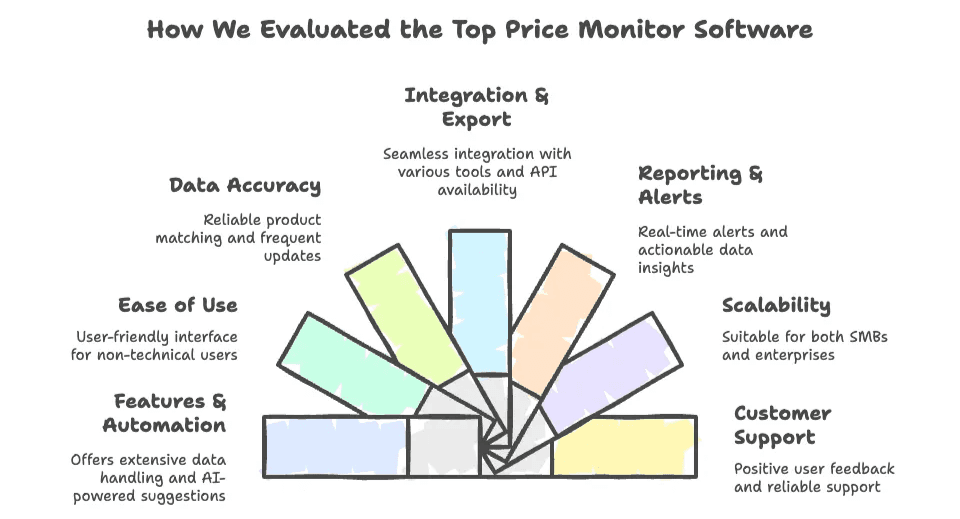
- Features & Automation: Can it handle large-scale data scraping, scheduled checks, pagination, subpages, and dynamic content? Does it offer extras like repricing rules or AI-powered suggestions?
- Ease of Use: Is it friendly for non-technical users? Can you get started without a PhD in web scraping?
- Data Accuracy & Product Matching: Does it reliably match your products to competitors’? How often does it update, and can it handle tricky variants?
- Integration & Export Options: Can you easily export to Excel, Google Sheets, or your BI tool? Is there an API?
- Reporting & Alerts: Are there dashboards, charts, and real-time alerts? Can you actually act on the data?
- Scalability: How many products and competitors can it handle? Is it built for SMBs, enterprises, or both?
- Customer Support & Reviews: I dug into user feedback on , , , and the Chrome Store. Real-world experiences matter.
I also looked for tools that deliver real ROI, not just a pile of data you have to clean up yourself. If a tool made users say “it’s like having an intern,” it got bonus points in my book.
Quick Comparison Table: Top 15 Price Monitor Software at a Glance
Here’s a side-by-side look at the top contenders. (Spoiler: is first for a reason.)
| Tool | Key Features | Best For | Pros | Cons | User Rating |
|---|---|---|---|---|---|
| Thunderbit | AI field detection, scheduled cloud scrapes, subpage/pagination, instant export | Non-technical users, SMBs | Easiest setup, powerful automation, free exports | Credit-based limits for heavy use | 4.9★ (Chrome Store) |
| Model N | Revenue management, global pricing, compliance, analytics | Pharma, medtech, high-tech | Enterprise-grade, compliance, analytics | Complex, expensive, steep learning curve | 4.6/5 (G2) |
| Mozenda | Visual scraping, scheduling, PDF/Word scraping | Analysts, custom price intelligence | Flexible, scalable, great support | Windows-only, pricey, learning curve | 4.4/5 (SoftwareAdvice) |
| Omnia | Dynamic pricing, competitor monitoring, real-time insights | Omnichannel retailers | Automation, integrations, dashboards | Integration complexity, price | 4.4/5 (G2) |
| Price2Spy | Competitor tracking, alerts, dashboards, repricing | Ecommerce, retail | Easy setup, affordable, alerts | Manual setup for large catalogs | 4.8/5 (G2) |
| Pricefy | Real-time alerts, dynamic pricing, catalog analysis | SMBs, brands | Real-time, integrations, catalog insights | Newer, fewer reviews, custom pricing | N/A |
| Data Crops | Automated scraping, customizable dashboards, API | Large retailers, manufacturers | Scalable, customizable, robust | Enterprise focus, setup complexity | N/A |
| PriceGrid | Browser-based, open-source, API, notifications | Tech-savvy, self-hosters | Free/OSS, flexible, API | Manual setup, limited support | Niche |
| Import.io | Advanced scraping, scheduling, anomaly detection | Data teams, analysts | Flexible, API, file downloads | Pricey, learning curve | 4.5/5 (G2) |
| Zilliant | Predictive analytics, price optimization, B2B focus | B2B, manufacturing | AI-driven, complex pricing | Expensive, B2B only | 4.5/5 (Capterra) |
| PROS | AI price optimization, CPQ, real-time pricing | Large enterprises | Advanced AI, industry-specific | Cost, complexity | 4.0–4.5/5 (Gartner) |
| Skuuudle | Competitor monitoring, product matching, analytics | Retailers, brands | Accurate data, scalable, integrations | Advanced features need setup | 4.5/5 (G2) |
| Prisync | Unlimited competitors, dynamic pricing, alerts | SMBs, ecommerce | Unlimited tracking, easy to use | Cost scales with products | 4.7/5 (G2) |
| Luminate Market Price | AI price setting, demand-based pricing | Large retailers | Intelligent automation, analytics | Enterprise-only, setup | N/A |
| Dealavo | Multichannel monitoring, MAP enforcement, analytics | Brands, manufacturers | Multi-channel, MAP alerts, dashboards | Setup, custom pricing | 4.3/5 (G2) |
| Minderest | Price intelligence, assortment analytics, alerts | Retailers, brands | Deep insights, assortment tools | Cost, learning curve | 4.5/5 (G2) |
Now, let’s dig into each tool—starting with the one I know best.
Thunderbit: AI-Powered Price Monitoring and Data Scraping
Alright, I’ll admit it: I’m a little biased here, but for good reason. At , our mission is to make price monitoring and data scraping as easy as ordering takeout. No code, no headaches—just results.
What Makes Thunderbit Stand Out
- AI-Powered Simplicity: With our “AI Suggest Fields” feature, you just click a button and Thunderbit figures out what data to grab—product names, prices, ratings, you name it. It’s like having a mini data scientist in your browser.
- Scheduled Scraper: Want to track prices every morning? Just type “every day at 9am” and Thunderbit will run in the cloud, scraping your competitors’ sites and exporting the results to Google Sheets, Excel, Airtable, or Notion—totally free.
- Subpage & Pagination Scraping: Thunderbit doesn’t stop at the first page. It can click into every product, handle infinite scroll, and grab deep details like stock status and descriptions.
- Instant Data Export: Export to Excel, Google Sheets, Airtable, or Notion in one click. No CSV wrangling required.
- Templates for Popular Sites: Need to scrape Amazon, Zillow, or Shopify? We’ve got instant templates for that—no setup needed.
- All-in-One Data Cleaning: Thunderbit can deduplicate, clean, and even transform your data with AI prompts.
Real User Feedback
- Chrome Store: 4.9★ with 20,000+ users. One review called it “like having an intern doing the copy-pasting”—and honestly, that’s the vibe we’re going for.
- G2 & Capterra: Users love the 2-click setup and the fact that it’s surprisingly powerful for a browser extension. Our support team gets high marks for responsiveness.
Pros & Cons
Pros:
- Easiest setup in the business—install, click, done.
- AI does the heavy lifting for field detection.
- Scheduled cloud scraping for true automation.
- Free exports to all major formats.
- Handles subpages, pagination, and even logged-in data.
Cons:
- Credit-based system: 1 row = 1 credit. Heavy users may need a higher plan (starts at $15/mo for 500 credits).
- For very complex or anti-scraping sites, you might need to tweak settings.
- Occasionally, the AI needs a nudge if a page has multiple price fields.
Typical Use Case
An ecommerce manager wants to track 20 competitor products on Amazon and Shopify. She clicks “AI Suggest” on each competitor’s page, sets up a daily schedule, and wakes up every morning to a fresh Google Sheet with all the latest price changes—no more manual checks.
Want to see it in action? or check out our for more tips.
Model N: Price Monitoring for Regulated Industries
Model N is the heavyweight champion for industries where pricing isn’t just about competition—it’s about compliance, contracts, and government rules. Think pharma, medtech, and high-tech manufacturing.
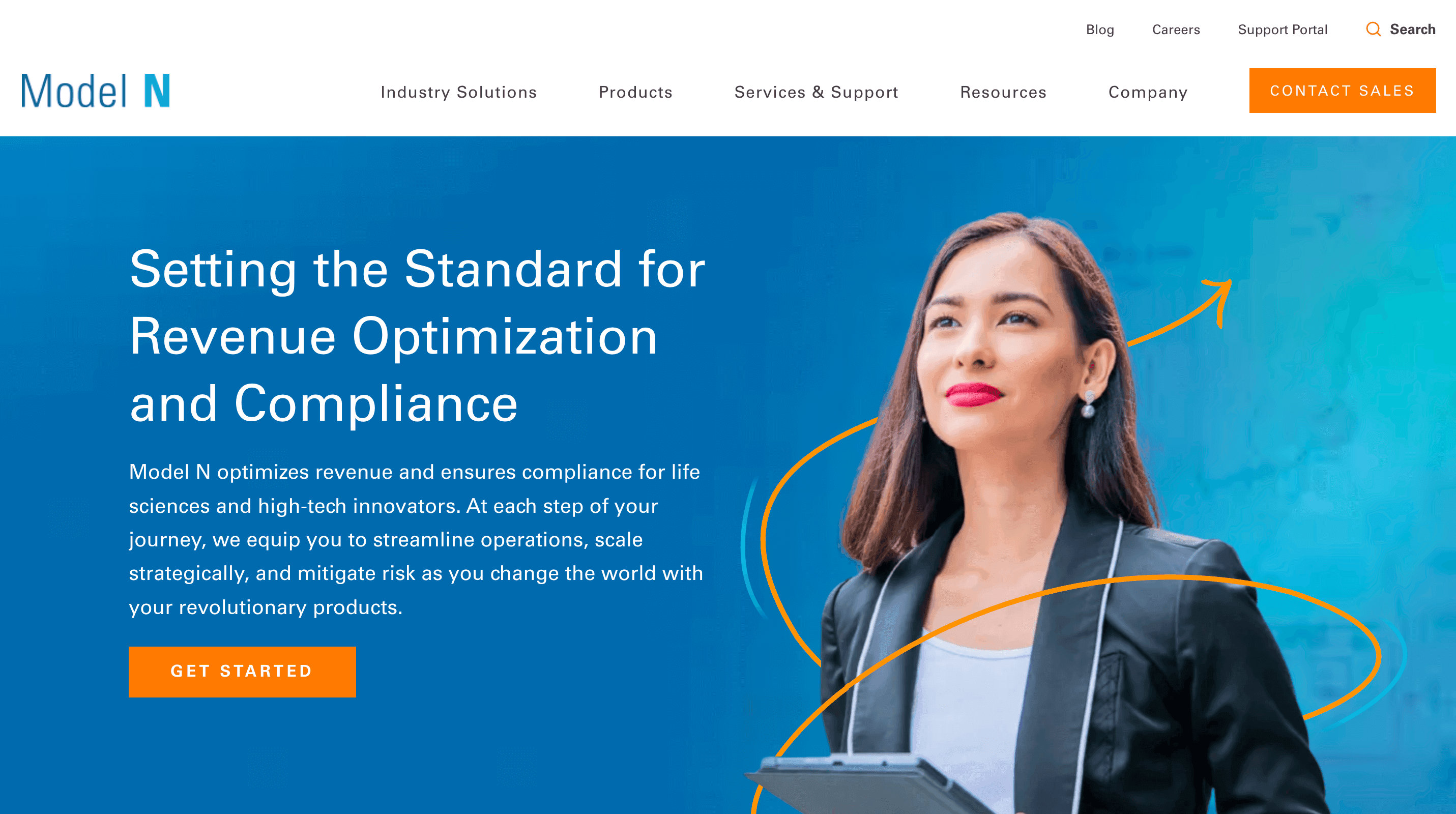
What It Does
- Revenue Management Suite: Handles everything from quoting (CPQ) to global pricing governance and rebate management.
- Global Price Monitoring: Tracks prices across dozens of countries, simulates the impact of price changes, and ensures compliance with international reference pricing.
- Analytics & Alerts: Offers price waterfall charts, approval workflows, and real-time alerts for anomalies or unauthorized discounts.
Pros & Cons
Pros:
- Built for complex, regulated industries.
- Deep analytics and compliance features.
- Integrates with Salesforce, SAP, and other enterprise systems.
Cons:
- Overkill for simple retail or ecommerce needs.
- Complex to implement and expensive.
- Steep learning curve—best for companies with dedicated pricing teams.
User Feedback
Model N scores for high-tech, with users praising its ability to handle “every iteration of pricing, quoting, contracting.” But be prepared for a serious onboarding process.
Mozenda: Flexible Data Scraping for Price Intelligence
Mozenda is the Swiss Army knife of web data extraction. If you need to scrape pricing data from a variety of sources—websites, PDFs, Word docs—Mozenda can handle it.
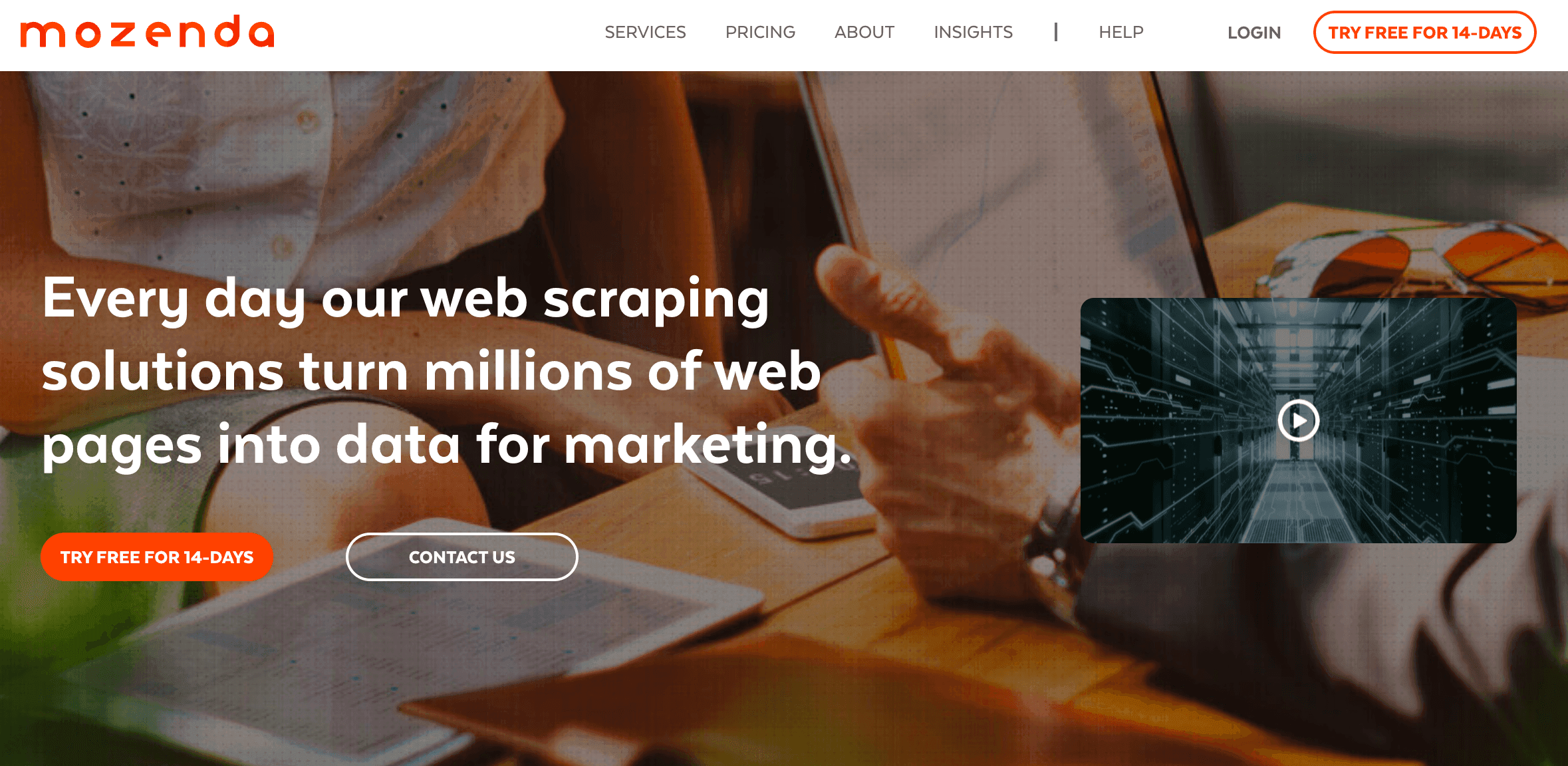
What It Does
- Visual Point-and-Click Scraping: Build agents by clicking through websites. No coding required (unless you want to get fancy).
- Cloud Scheduling: Run your scrapers on Mozenda’s cloud, with multi-threading for speed.
- Advanced Features: Handles complex sites, document scraping, and has strong error handling.
Pros & Cons
Pros:
- Highly customizable and scalable.
- Great for analysts who need raw data for custom analysis.
- Excellent support, even on lower-tier plans.
Cons:
- Windows-only client for building agents.
- Subscription starts around $250/month.
- Learning curve for debugging complex scrapes.
User Feedback
Rated , users praise its reliability and support, but some wish for a more flexible pricing model.
Omnia: Dynamic Pricing and Price Monitoring
Omnia is a powerhouse for retailers who want to automate not just price monitoring, but also dynamic pricing across channels.
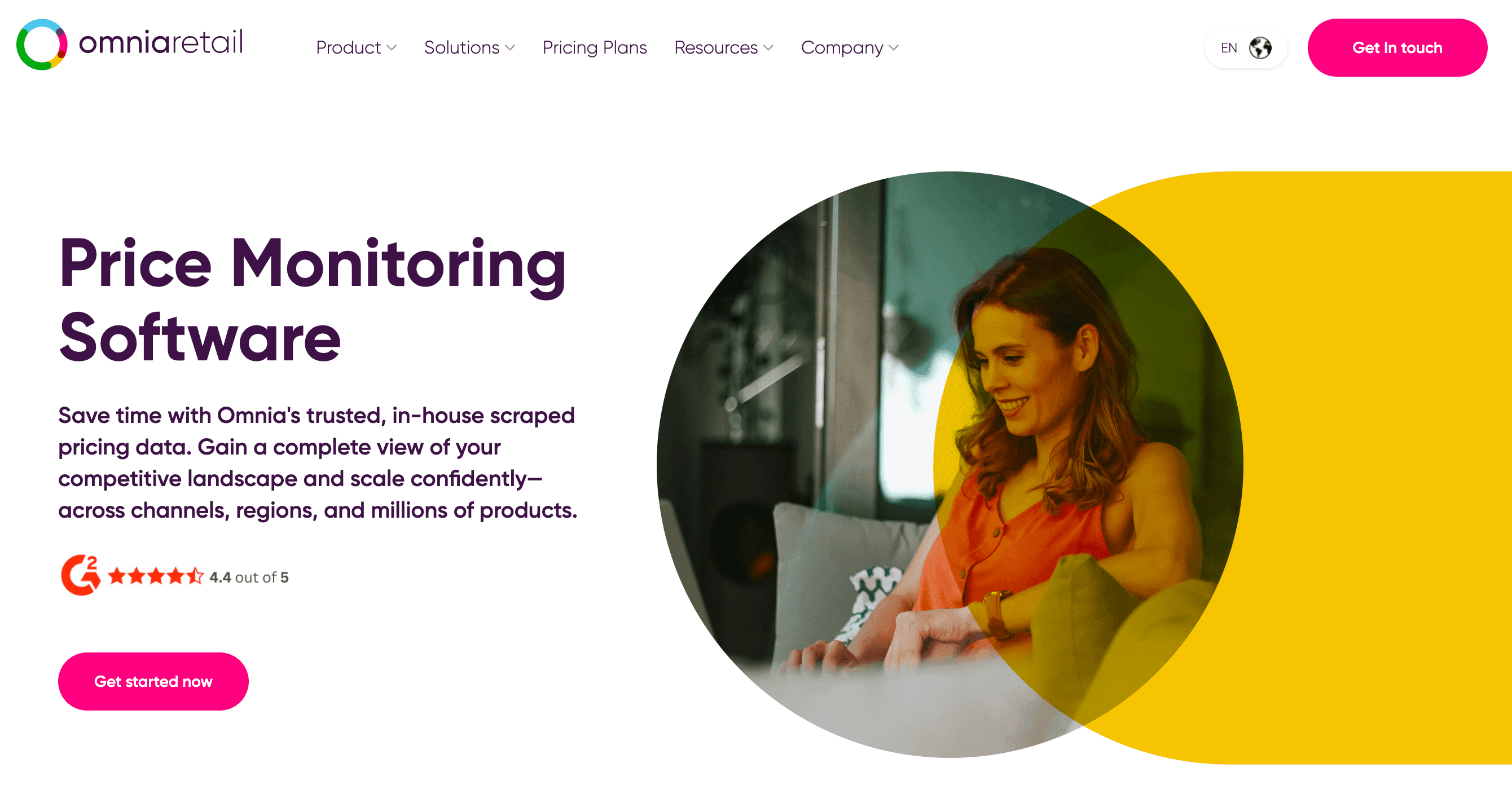
What It Does
- Pricewatch: Monitors competitor prices and provides real-time market insights.
- Dynamic Pricing Engine: Automates price changes based on rules, demand, and competition.
- Integrations: Works with ecommerce platforms, ERPs, and comparison shopping engines.
Pros & Cons
Pros:
- End-to-end automation from monitoring to repricing.
- Scalable for large catalogs and multi-country operations.
- Strong dashboards and analytics.
Cons:
- Integration can be complex.
- Custom pricing, with starting packages around €399/month.
- Some users want more customization.
User Feedback
Omnia scores , with users loving the automation and market insights, but noting the setup can be intense.
Price2Spy: Comprehensive Price Tracking for Ecommerce
Price2Spy is a veteran in the price monitoring game, especially for ecommerce and retail.
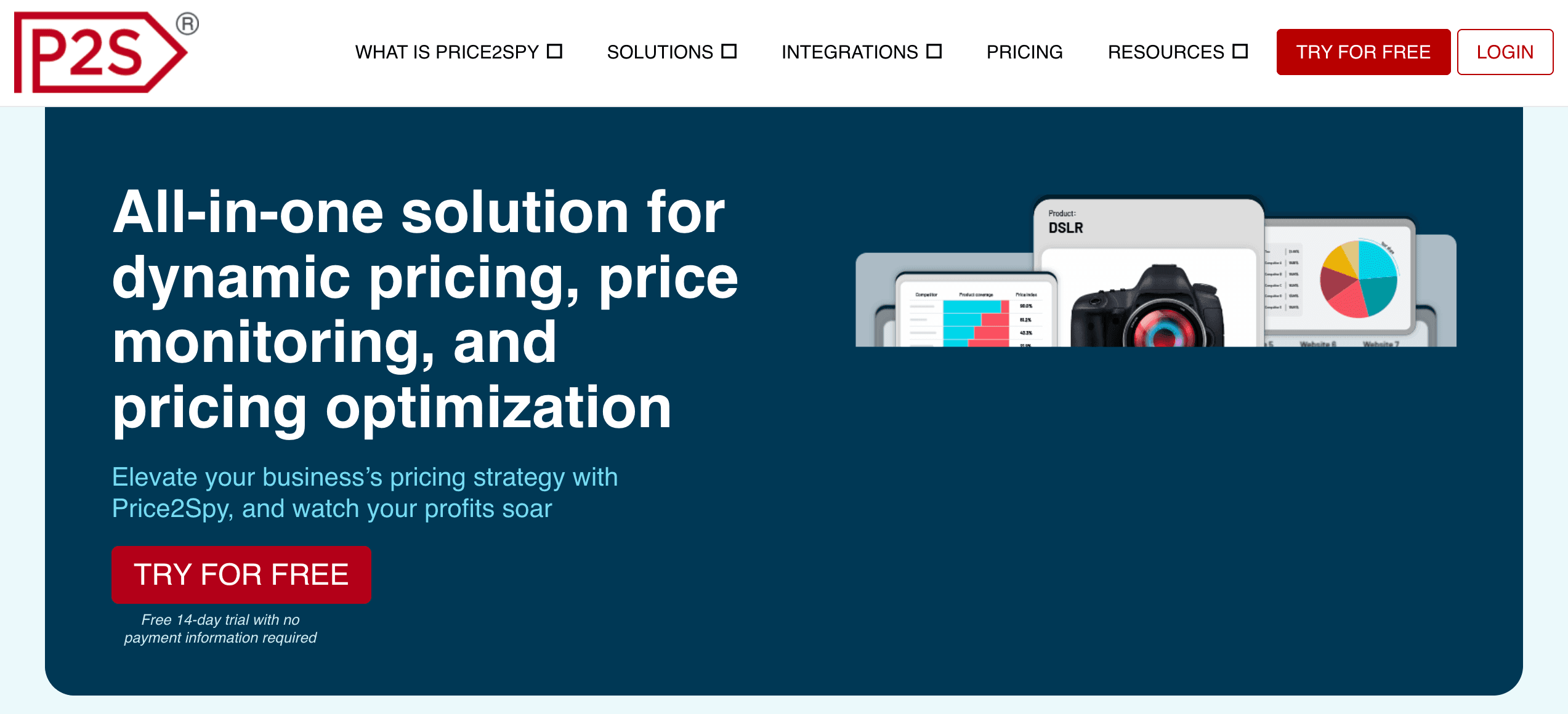
What It Does
- Flexible Monitoring: Tracks prices across websites, marketplaces, and even offline stores.
- Alerts & Dashboards: Real-time or daily email alerts, historical price charts, and under/overpricing reports.
- Repricing Module: Suggests or automates price changes based on competitor data.
Pros & Cons
Pros:
- Easy to set up and use.
- Affordable for SMBs (starts at ~$20/month).
- Unlimited competitor tracking.
Cons:
- Manual setup for large catalogs.
- Basic UI design.
- Advanced features require higher plans.
User Feedback
Highly rated—. Users call it “affordable and effective,” especially for SMBs.
Pricefy: Real-Time Price Alerts and Data Scraping
Pricefy is a newer player, but it’s making waves with real-time alerts and catalog analysis.
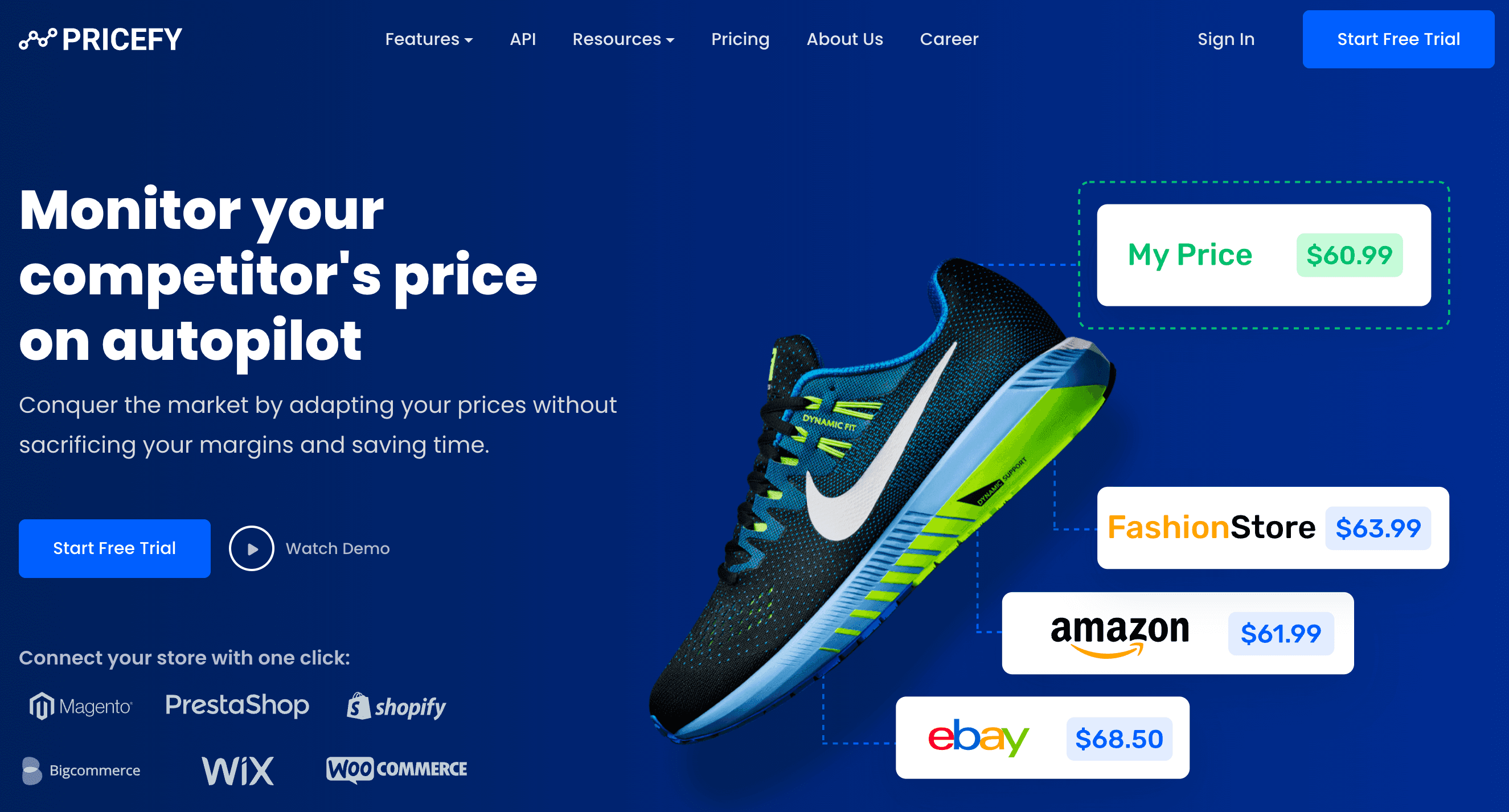
What It Does
- Real-Time Alerts: Notifies you instantly when competitors change prices.
- Dynamic Pricing: Suggests and automates price changes.
- Catalog Analysis: Compares your product content and reviews to competitors.
Pros & Cons
Pros:
- Real-time updates and alerts.
- Integrates with major ecommerce platforms.
- Unique catalog quality analysis.
Cons:
- Newer, so fewer third-party reviews.
- Custom pricing, not always transparent.
User Feedback
Early users praise its modern interface and actionable insights, but it’s still building its reputation.
Data Crops: Automated Price Intelligence
Data Crops is for the big leagues—think enterprises tracking millions of prices across thousands of competitors.
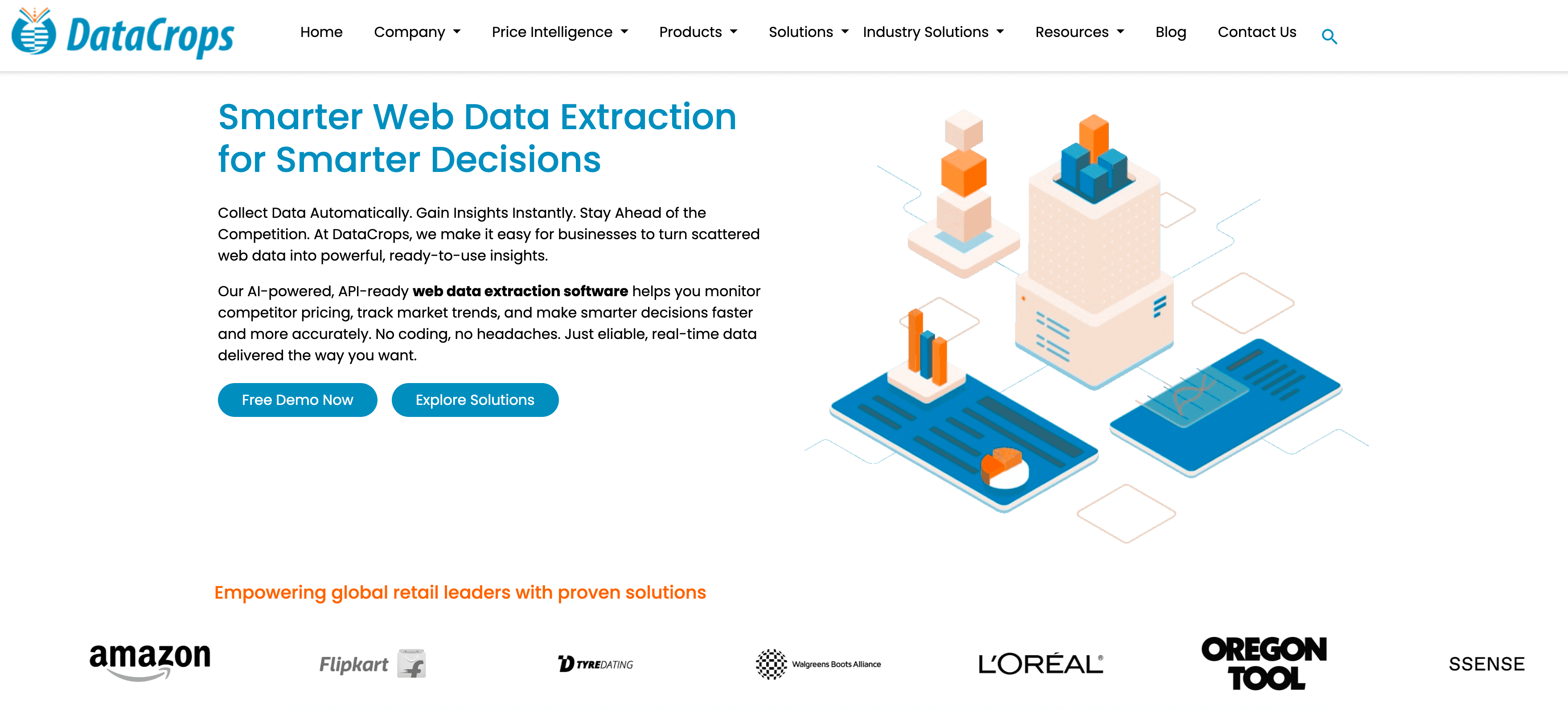
What It Does
- Automated Web Scraping: Handles massive scale, real-time monitoring, and customizable dashboards.
- API & Integration: Feeds data directly into your systems.
- Custom Alerts: Set up notifications for specific price changes or trends.
Pros & Cons
Pros:
- Highly scalable and robust.
- Customizable for any industry.
- Strong automation and integration.
Cons:
- Complex to implement—best for enterprises.
- Pricing is custom and typically high.
User Feedback
Not many public reviews, but enterprise users value its reliability and customization.
PriceGrid: Browser-Based Price Monitoring
PriceGrid is a favorite among techies and self-hosters.
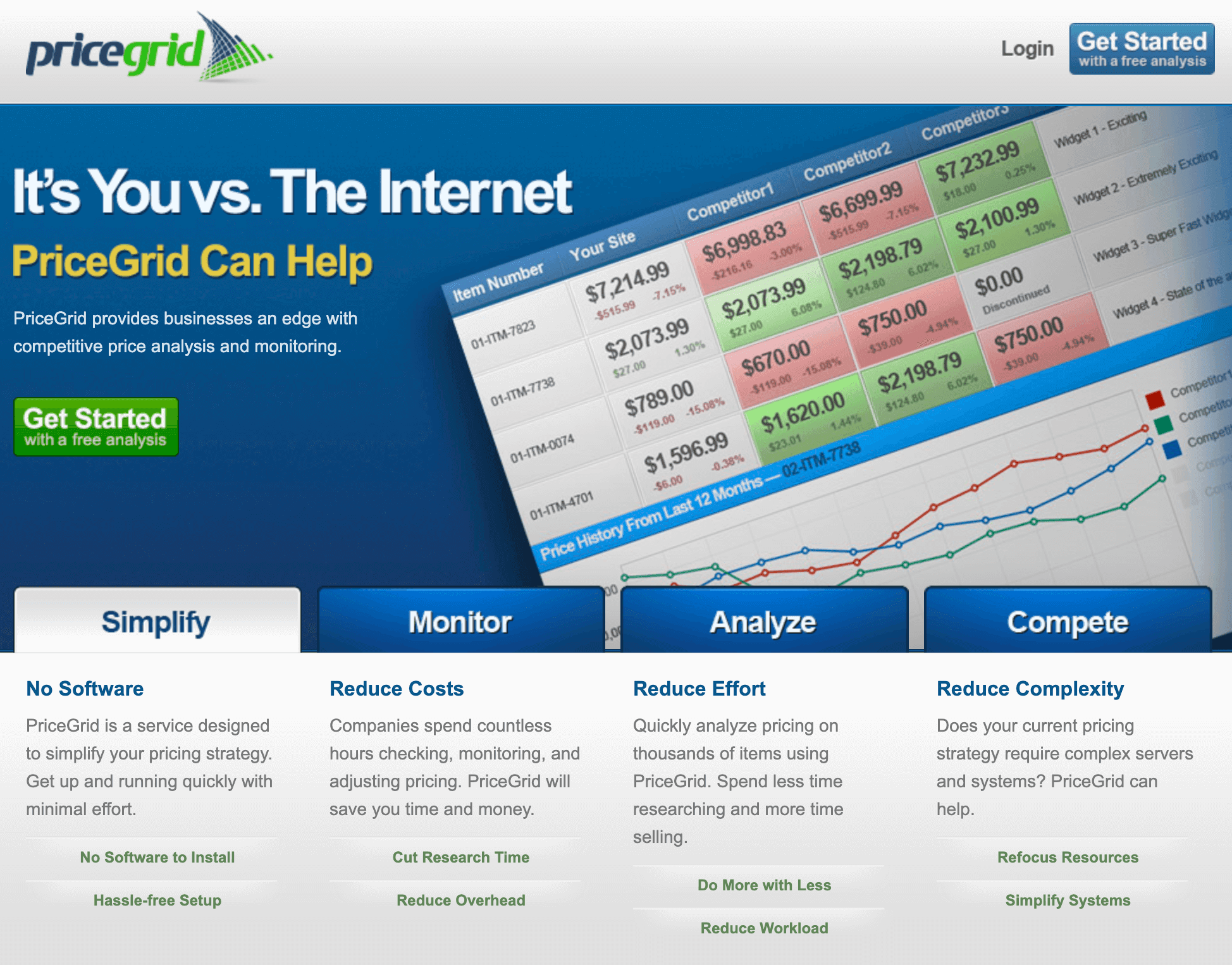
What It Does
- Browser-Based & Open Source: Use it online or self-host your own instance.
- API & Notifications: Get alerts and integrate with other apps.
- Free Reports: Analyze prices for thousands of products.
Pros & Cons
Pros:
- Free and open-source options.
- Flexible and API-friendly.
- Great for custom setups.
Cons:
- Manual setup required.
- Limited support and community.
User Feedback
Niche but loved by those who want full control.
Import.io: Advanced Data Scraping for Price Monitoring
Import.io is a data extraction powerhouse for teams that need more than just price monitoring.
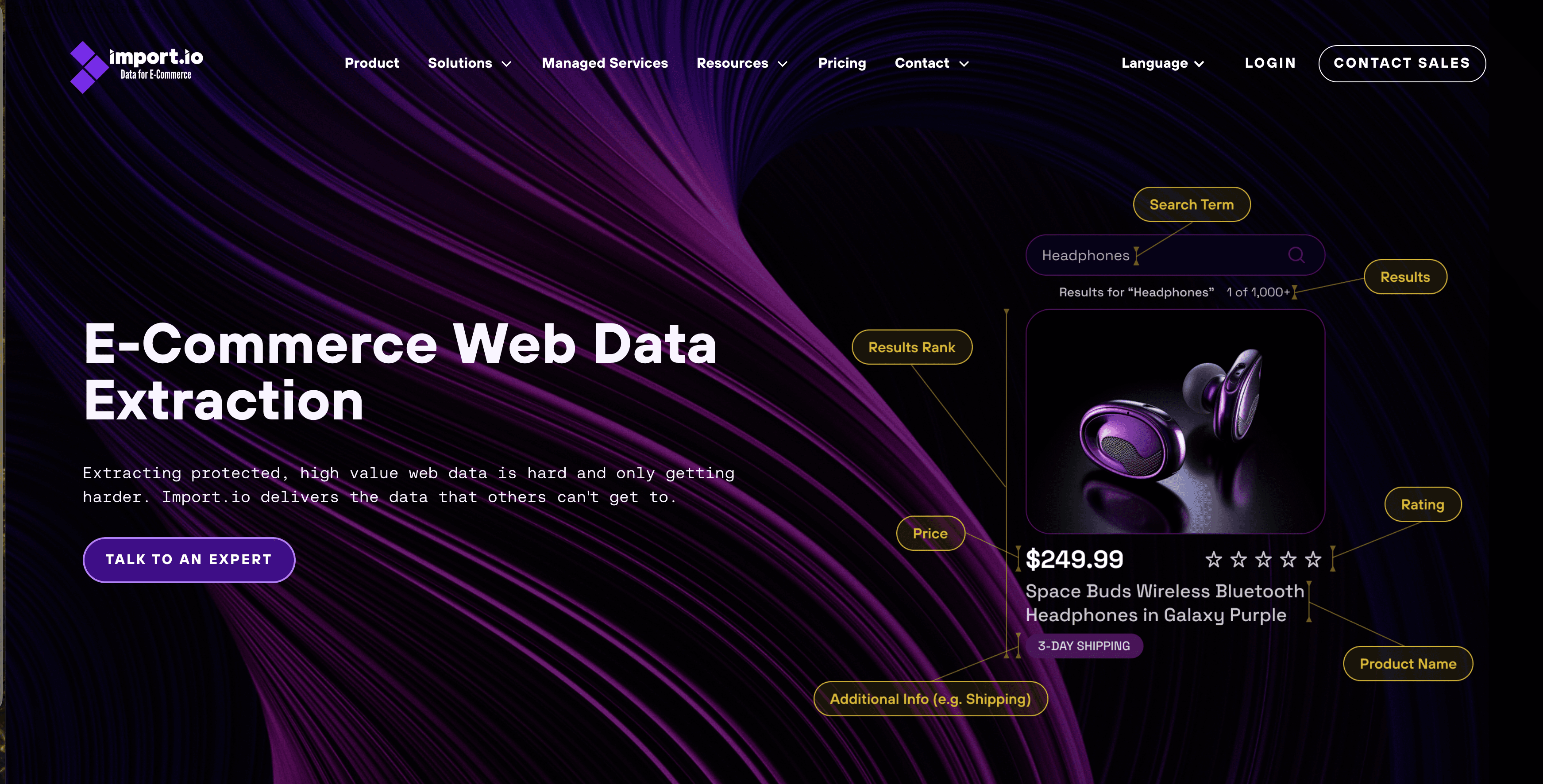
What It Does
- Custom Scraping: Build scrapers for any website, no coding needed.
- Scheduling & API: Automate data collection and feed it into your systems.
- Anomaly Detection: Flags suspicious price changes.
Pros & Cons
Pros:
- Extremely flexible and powerful.
- Handles complex sites and data types.
- Strong API and integration.
Cons:
- Pricey, especially for frequent or large-scale use.
- Learning curve for advanced features.
User Feedback
Rated , users love its reliability and flexibility.
Zilliant: Predictive Pricing and Sales Analytics
Zilliant is built for B2B companies with complex pricing needs.
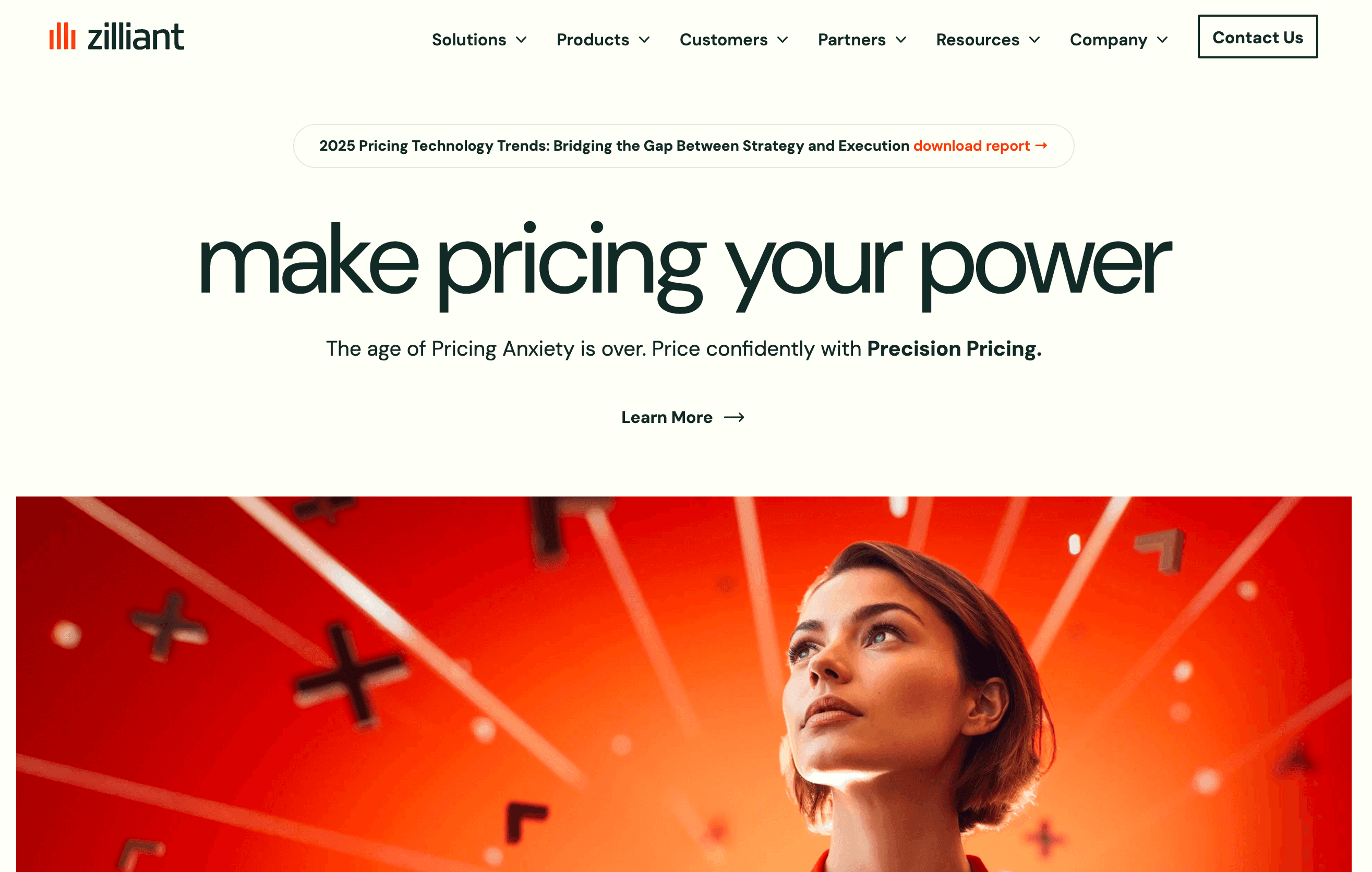
What It Does
- AI-Driven Price Optimization: Recommends optimal prices for each customer and product.
- Sales Analytics: Provides predictive insights and deal guidance.
- Integration: Works with CRM and ERP systems.
Pros & Cons
Pros:
- Handles complex B2B pricing scenarios.
- Predictive analytics boost margins.
- Scalable for large enterprises.
Cons:
- Not designed for B2C price scraping.
- Expensive and requires significant setup.
User Feedback
Praised for managing “Excel hell” in B2B pricing, with .
PROS: AI-Driven Price Optimization
PROS is a veteran in AI-powered pricing, especially for industries like airlines and manufacturing.
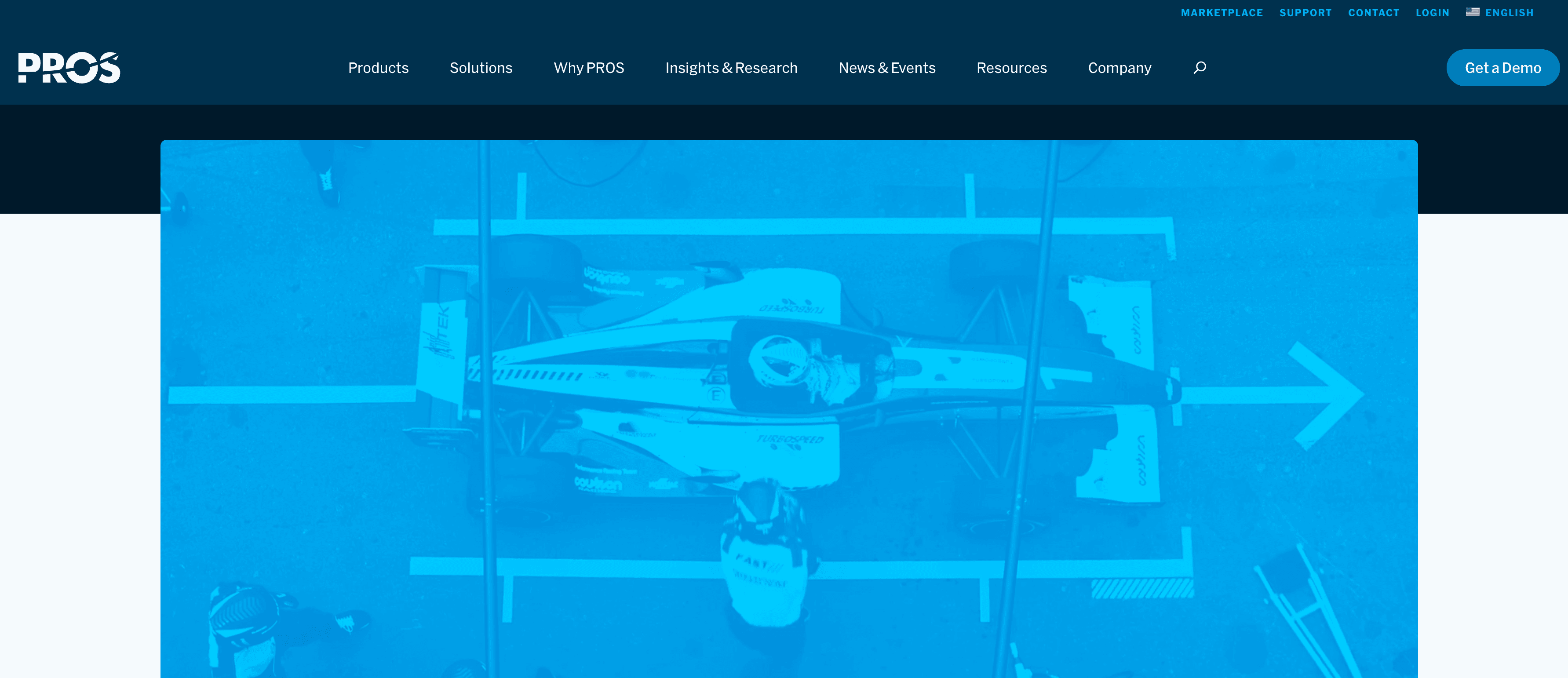
What It Does
- Dynamic Pricing: Real-time price optimization across channels.
- CPQ & Revenue Management: Automates quoting and manages complex discount structures.
- Industry-Specific Modules: Tailored for airlines, automotive, and more.
Pros & Cons
Pros:
- Advanced AI and machine learning.
- Comprehensive suite for large enterprises.
- Proven revenue uplift.
Cons:
- High cost and complexity.
- Steep learning curve.
User Feedback
Generally , with users noting it’s “best-in-class for complex pricing.”
Skuuudle: Competitor Price Monitoring for Ecommerce
Skuuudle specializes in competitor price monitoring with automated product matching.
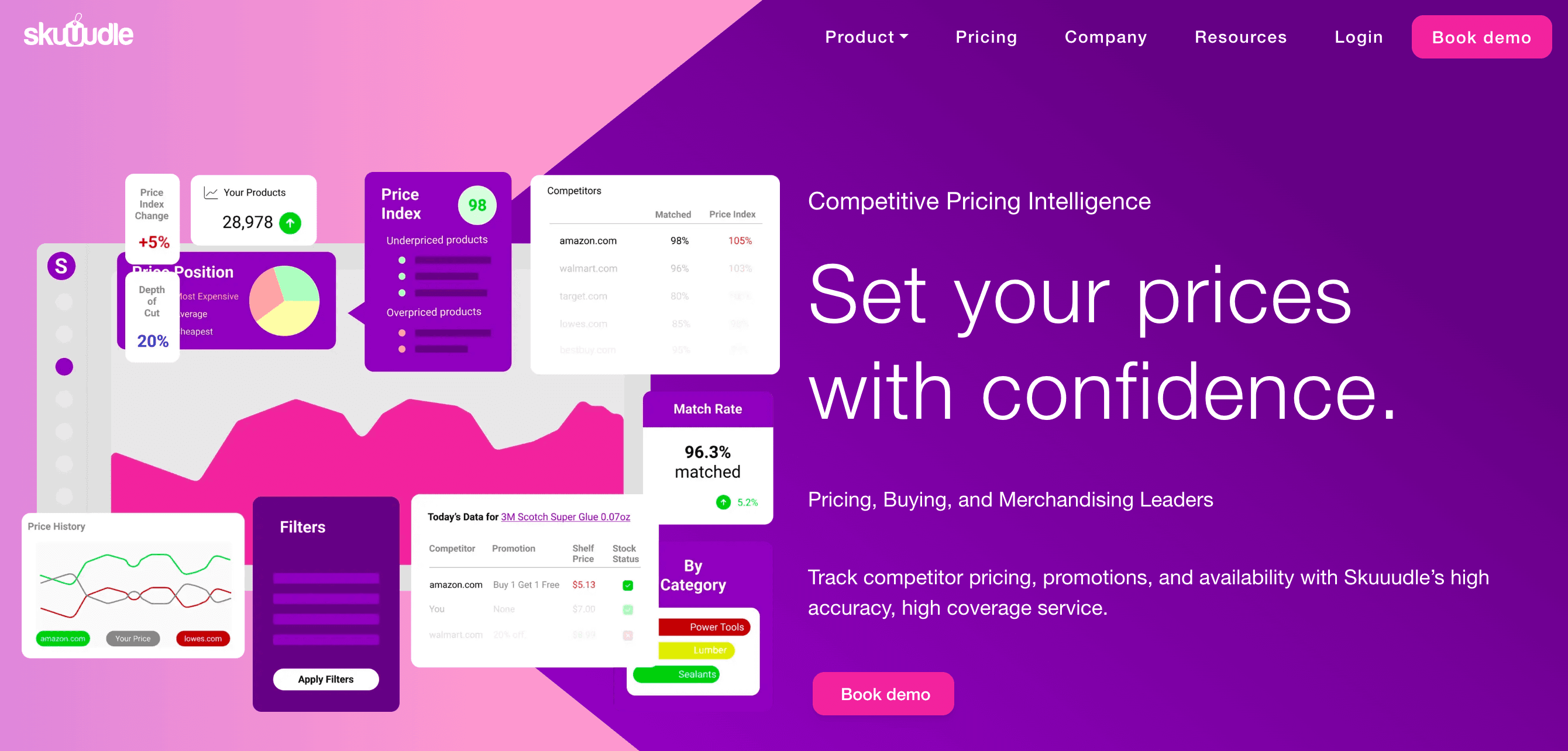
What It Does
- Automated Product Matching: Finds and matches your products to competitors’.
- Analytics Dashboards: Visualize pricing trends and market gaps.
- Quality Control: Ensures data accuracy with tech and manual checks.
Pros & Cons
Pros:
- High-quality, accurate data.
- Scalable for large catalogs.
- Integrations and custom reports.
Cons:
- Advanced features require setup.
- Some manual work for custom analysis.
User Feedback
Consistently , users love the accuracy and support.
Prisync: Unlimited Competitor Tracking
Prisync is a favorite for SMBs who want unlimited competitor tracking and dynamic pricing.
![]()
What It Does
- Unlimited Competitor Monitoring: Track as many rivals as you want for each product.
- Dynamic Pricing Engine: Set rules to automate price changes.
- Real-Time Alerts & Reports: Stay on top of every move.
Pros & Cons
Pros:
- Unlimited tracking per product.
- Easy to use and set up.
- Integrates with Shopify, WooCommerce, and more.
Cons:
- Cost scales with number of products.
- Advanced features in higher tiers.
User Feedback
Excellent reviews—, with users saying it “saved countless hours.”
Luminate Market Price: Intelligent Price Setting
Luminate Market Price (from Blue Yonder) is all about using AI to automate pricing decisions at scale.
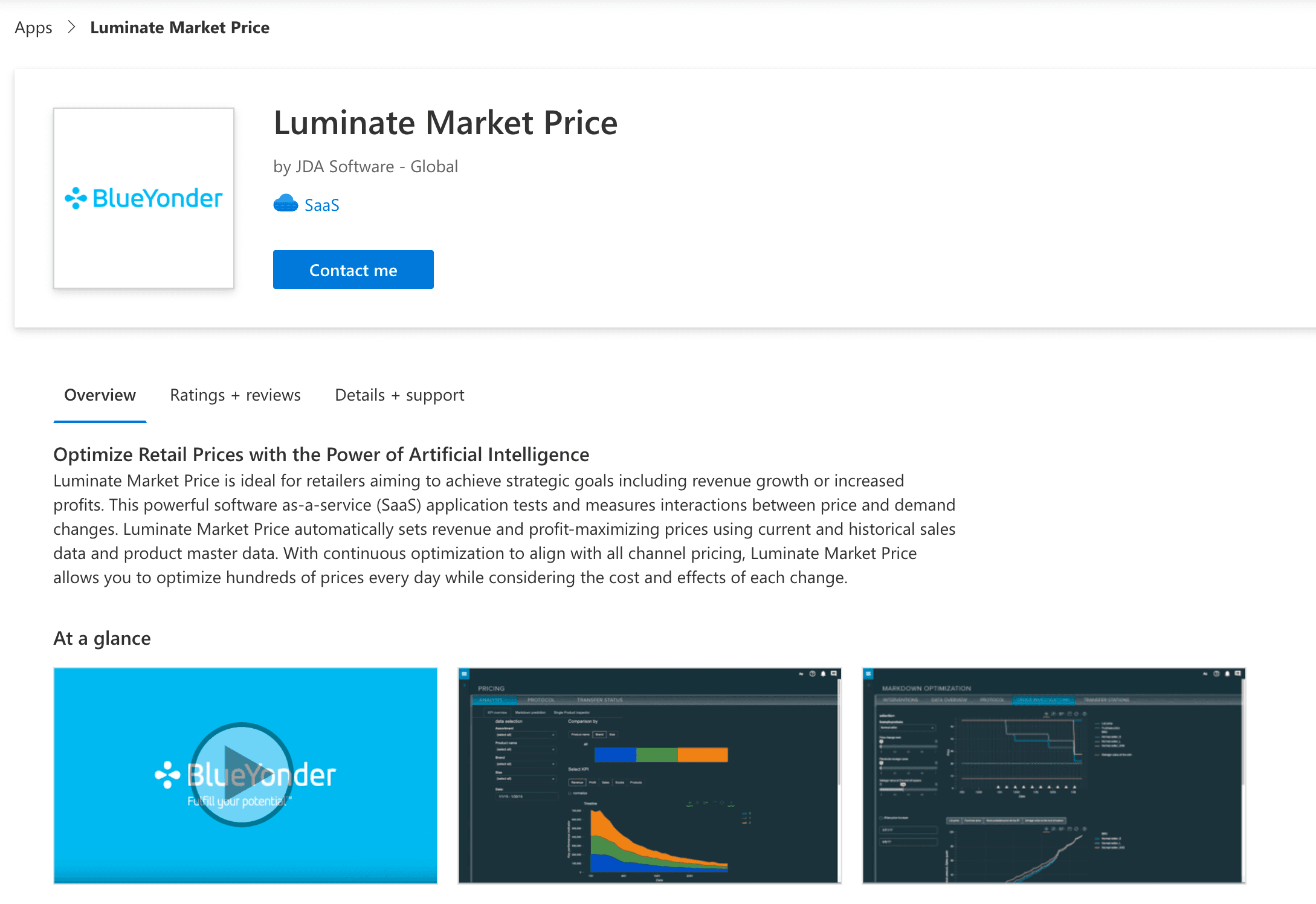
What It Does
- AI-Driven Price Optimization: Sets prices based on demand, inventory, and historical data.
- Simulation Tools: Predicts the impact of price changes.
- Enterprise Integration: Fits into broader retail planning systems.
Pros & Cons
Pros:
- Intelligent, demand-based pricing.
- Handles promotions and markdowns.
- Learns and improves over time.
Cons:
- Enterprise-only, requires lots of data.
- Not a plug-and-play solution.
User Feedback
Praised by large retailers for optimizing margins, but not many public reviews.
Dealavo: Multichannel Price Monitoring
Dealavo is built for brands and manufacturers who need to track prices across multiple channels.
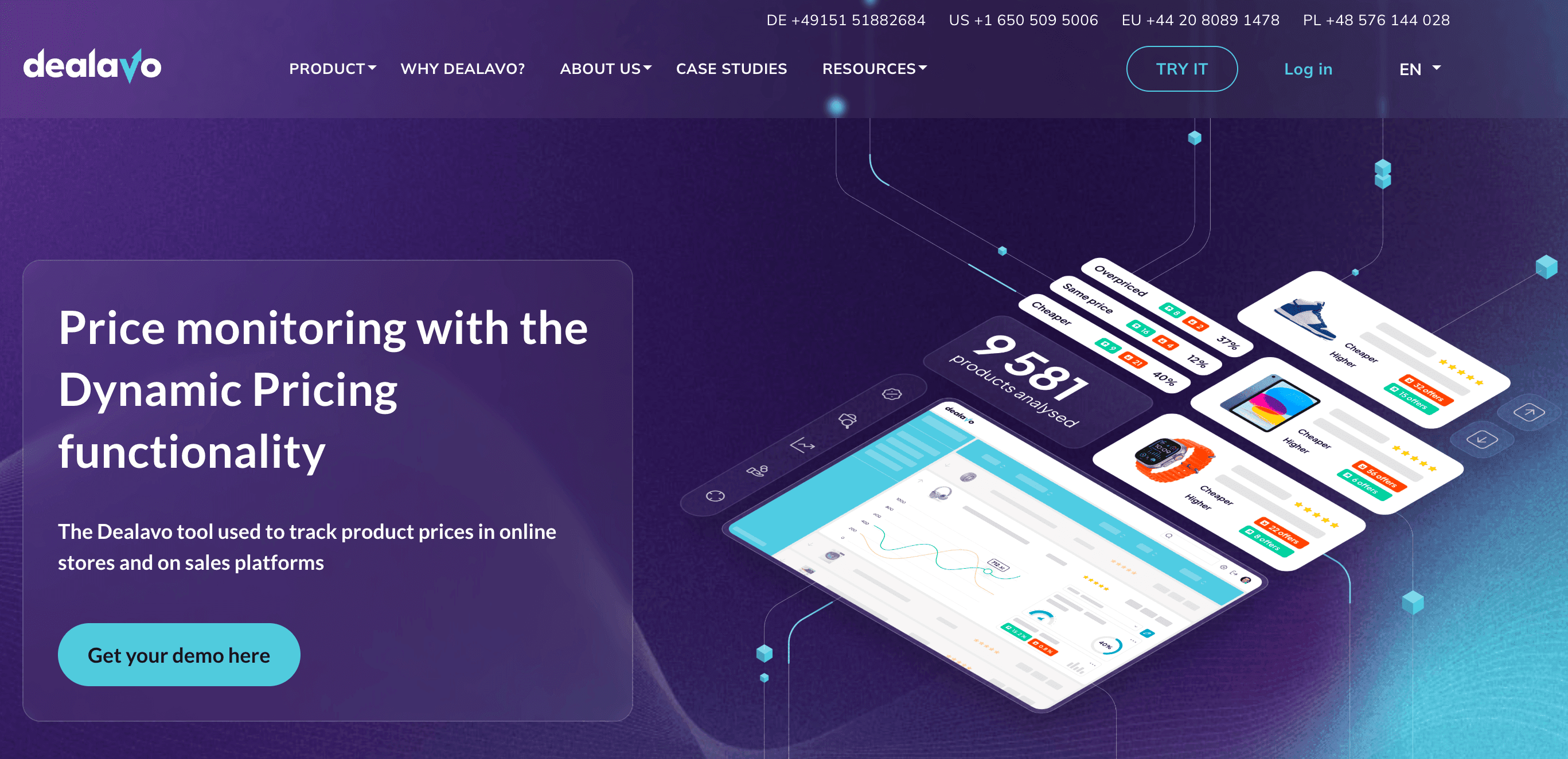
What It Does
- Multichannel Monitoring: Tracks prices on online stores, marketplaces, and comparison sites.
- MAP Enforcement: Flags violations of minimum advertised price.
- Dynamic Pricing & Analytics: Provides actionable insights and dashboards.
Pros & Cons
Pros:
- Covers all major channels.
- Strong MAP monitoring.
- Customizable alerts and reports.
Cons:
- Setup required for product matching.
- Custom pricing, enterprise focus.
User Feedback
Rated , users love the comprehensive market overview.
Minderest: Price Intelligence for Retailers
Minderest is a top pick for retailers who want deep insights into both pricing and product assortment.
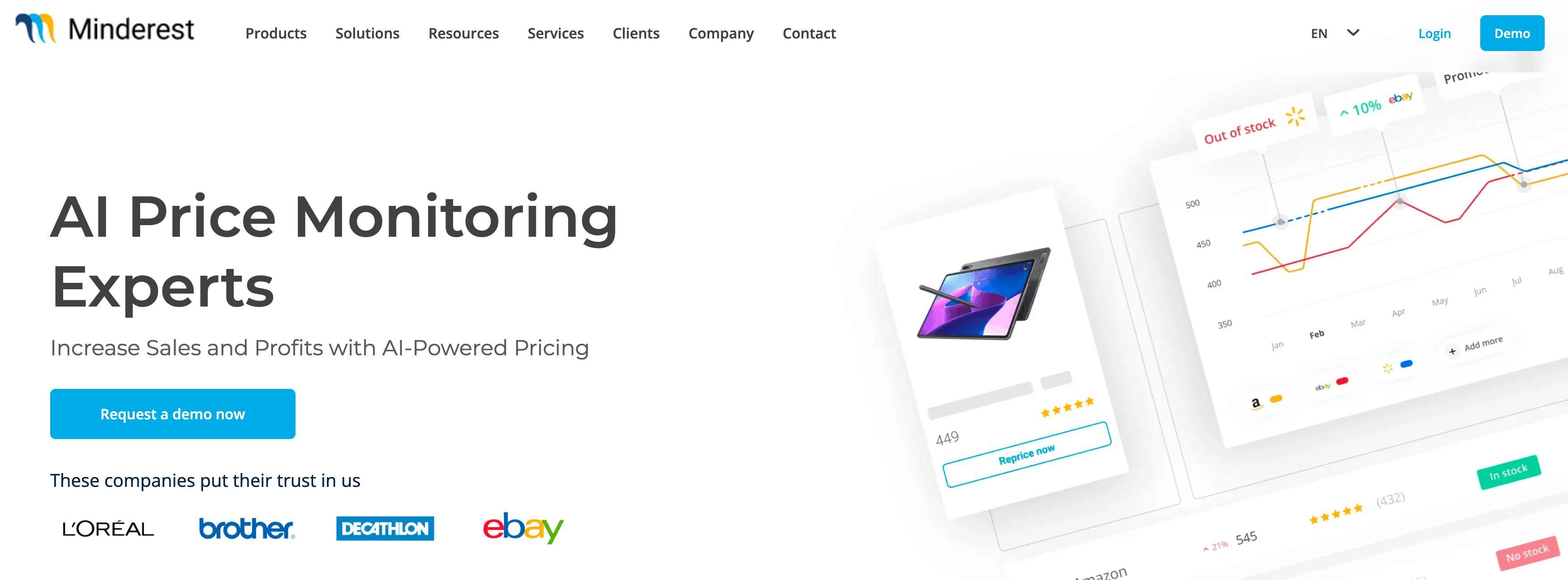
What It Does
- Competitor Price & Assortment Tracking: See not just prices, but what products competitors carry.
- Detailed Analytics: Evaluate pricing strategy, promotions, and stock availability.
- Dynamic Pricing Rules: Set and automate pricing based on market data.
Pros & Cons
Pros:
- Detailed, actionable insights.
- Robust assortment analysis.
- Excellent customer support.
Cons:
- Premium pricing.
- Learning curve for advanced features.
User Feedback
Consistently , users say it’s “invaluable for strategic planning.”
How to Choose the Best Price Monitor Software for Your Business
So, which tool should you pick? Here’s my advice after years in the trenches:
- Size Matters: SMBs and solo operators will love tools like Thunderbit, Price2Spy, or Prisync—easy setup, affordable, and no IT headaches. Enterprises or regulated industries should look at Model N, Data Crops, or PROS.
- Automation vs. Customization: If you want hands-off automation, prioritize tools with scheduled scraping, dynamic pricing, and integrations (Thunderbit, Omnia, Prisync). If you need deep customization, look at Mozenda or .
- Integration Needs: Make sure your tool can export data where you need it—Excel, Google Sheets, your ERP, or BI tool.
- Reporting & Alerts: Real-time alerts are a must for fast-moving markets. Dashboards and analytics help you make sense of the data.
- Support & Community: Check user reviews for support quality. A responsive team can save you hours of frustration.
And don’t be afraid to try before you buy—many tools offer free trials or demos.
Conclusion: Boost Your Business with the Right Price Monitor Software
In 2025, price monitoring isn’t just a competitive edge—it’s the cost of doing business. Whether you’re tracking 10 products or 10,000, the right price monitor software or price scraper can save you time, protect your margins, and help you make smarter decisions. I’ve seen teams go from drowning in spreadsheets to running circles around their competitors, all thanks to the right automation.
If you’re ready to level up, start with a tool that matches your needs and budget. And if you want a taste of what AI-powered simplicity feels like, give a spin. Your future self (and your bottom line) will thank you.
FAQs
1. What is price monitoring software and why is it essential in 2025?
Price monitoring software automatically tracks product prices across websites, marketplaces, or regions to help businesses stay competitive. In 2025, with millions of price changes happening daily (e.g., Amazon changes prices every 10 minutes per product), relying on manual checks is inefficient and risky. These tools help businesses protect margins, identify trends, and react quickly to competitors.
2. How do price monitoring tools benefit ecommerce businesses?
They offer key advantages like:
- Real-time competitor tracking
- Automated pricing adjustments
- Market trend insights
- Time savings from manual work
- Better margin protection and MAP enforcement
These benefits translate into improved decision-making and stronger ROI.
3. Which price monitoring tools are best for small businesses?
For SMBs and non-technical users, top choices include:
- Thunderbit: AI field detection, subpage scraping, scheduled exports, free integrations.
- Price2Spy: Easy setup, real-time alerts, affordable plans.
- Prisync: Unlimited competitor tracking with dynamic pricing rules.
4. What should I look for when choosing a price monitor tool?
Consider these factors:
- Automation capabilities (e.g., scheduled scraping, repricing rules)
- Data accuracy and product matching
- Ease of setup for non-developers
- Export/integration options (Google Sheets, APIs, etc.)
- Reporting tools (dashboards, alerts)
- Scalability for your catalog size and channels
5. How is Thunderbit different from other price tracking software?
Thunderbit stands out for its:
- No-code AI scraping that suggests data fields automatically
- Built-in templates for sites like Amazon and Shopify
- Scheduled cloud scraping with daily exports to Excel, Notion, and more
- User-friendly design with a 4.9★ Chrome Store rating
It's ideal for teams who want fast, accurate price data without needing a developer.
Learn More: